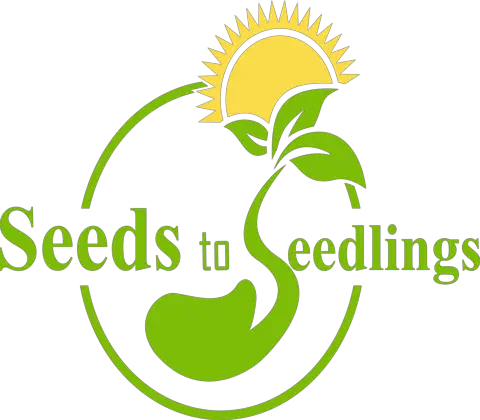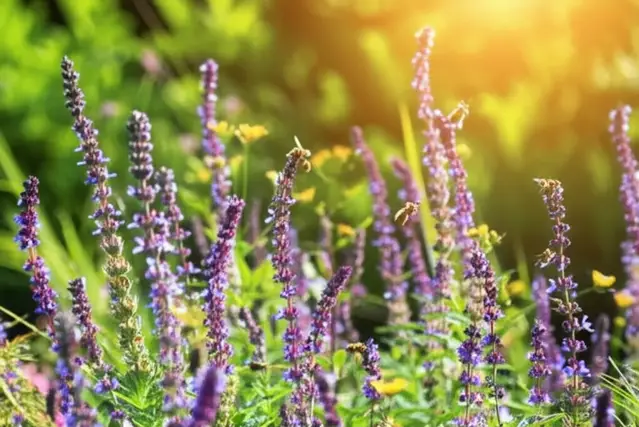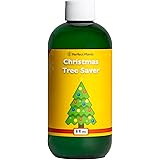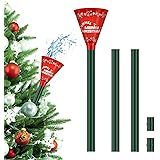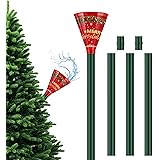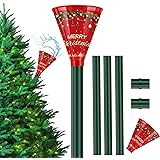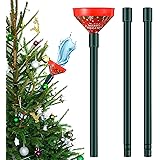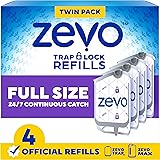Bees are vital to our ecosystem, playing a crucial role in pollinating plants that provide us with food and sustain our environment. Unfortunately, bee populations are declining due to habitat loss, pesticide use, and climate change. One of the most effective ways to support these essential pollinators is by creating a bee garden filled with wildflowers.
This guide will provide you with everything you need to know about how to start a bee garden with wildflowers, from planning and preparation to plant selection and maintenance.
Why Start a Bee Garden?
Creating a bee garden offers numerous benefits, both for the environment and for you:
- Supports Bee Populations: Provides a vital food source and habitat for bees, helping to counteract population decline.
- Enhances Pollination: Improves pollination in your garden and surrounding areas, leading to healthier plants and increased yields.
- Beautifies Your Space: Adds color and vibrancy to your garden with a diverse array of wildflowers.
- Promotes Biodiversity: Attracts a variety of pollinators and beneficial insects, increasing the overall biodiversity of your garden.
- Provides Educational Opportunities: Offers a chance to learn about bees, wildflowers, and the importance of ecological balance.
Planning Your Bee Garden
Before you start planting, careful planning is essential to ensure your bee garden thrives. Consider the following factors:
1. Location, Location, Location
Choose a location that receives at least six hours of sunlight per day. Bees need sunny spots to warm up and forage efficiently. Also, consider the proximity to a water source. A shallow dish of water with pebbles for bees to land on can be a lifesaver.
2. Soil Assessment
Most wildflowers prefer well-drained soil. Test your soil’s pH level and nutrient content. You can purchase a soil testing kit or send a sample to a local agricultural extension office. Amend the soil as needed with compost or other organic matter to improve drainage and fertility. Consider learning how to prepare the soil of my garden well to provide the best foundation for your wildflowers.
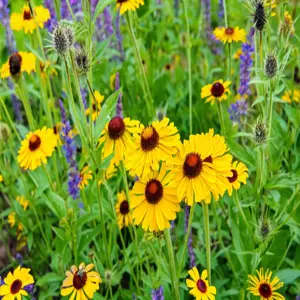
3. Garden Size and Design
Start with a manageable size. Even a small patch of wildflowers can make a big difference. Design your garden to provide a continuous bloom from early spring to late fall. This ensures a constant food source for bees throughout the growing season. Incorporate different heights, textures, and colors to create visual interest and attract a wider variety of bees.
4. Budgeting
Determine how much you’re willing to spend on seeds, plants, soil amendments, and tools. Wildflower seeds are generally inexpensive, but the cost can add up if you’re creating a large garden or purchasing specific varieties. Consider starting seeds indoors to save money and get a head start on the growing season. It is useful to know what a gardener does in the winter to keep your garden thriving throughout the year.
Choosing the Right Wildflowers
Selecting the right wildflowers is crucial for attracting bees. Native wildflowers are generally the best choice, as they are adapted to your local climate and soil conditions and provide the most nutritious pollen and nectar for native bees. Here are some key considerations:
1. Native vs. Non-Native Wildflowers
Native wildflowers are those that naturally occur in your region. They have co-evolved with local bee species and are often more attractive to them. Non-native wildflowers can still provide food for bees, but they may not be as nutritious or accessible. Always research the origin and potential invasiveness of non-native species before planting. There are some pros and cons of planting wildflowers, so be sure to consider them before making your selection.
2. Bloom Time
Choose a variety of wildflowers that bloom at different times throughout the growing season. This will ensure a continuous supply of food for bees from early spring to late fall. Create a bloom calendar to track when different species are expected to flower.
3. Flower Shape and Color
Bees are attracted to flowers with certain shapes and colors. They prefer flowers with open, shallow blooms that allow easy access to pollen and nectar. Bees are particularly drawn to blue, purple, yellow, and white flowers. Avoid highly hybridized or double-flowered varieties, as they often lack pollen and nectar.
4. Regional Recommendations
Consult with your local agricultural extension office or native plant society for recommendations on the best wildflowers for your region. They can provide valuable insights into which species are most beneficial to local bee populations. You can find a lot of informations about various plants, for example you can learn about all about yucca, or planting an amaryllis.
5. Top Wildflower Choices for Bees
Here’s a table with some popular and effective wildflower choices for attracting bees, categorized by bloom time and region. Note that availability may vary depending on your location.
| Wildflower | Bloom Time | Color | Region | Notes |
|---|---|---|---|---|
| Purple Coneflower (Echinacea purpurea) | Summer | Purple | Eastern and Central US | Attracts a wide variety of bees and butterflies |
| Bee Balm (Monarda spp.) | Summer | Red, Pink, Purple | Eastern and Central US | Highly attractive to bees and hummingbirds |
| Black-Eyed Susan (Rudbeckia hirta) | Summer to Fall | Yellow | Eastern and Central US | Easy to grow and provides long-lasting blooms |
| California Poppy (Eschscholzia californica) | Spring to Summer | Orange | Western US | Drought-tolerant and attracts native bees |
| Narrowleaf Milkweed (Asclepias fascicularis) | Summer | Pink | Western US | Essential for monarch butterflies and supports many bee species. |
| Blanket Flower (Gaillardia spp.) | Summer to Fall | Red and Yellow | Great Plains, Southwest | Very drought-tolerant and attracts bees and butterflies |
| Blue Flax (Linum lewisii) | Spring to Summer | Blue | Western North America | Attracts a variety of native bees with its delicate blue flowers. |
| Goldenrod (Solidago spp.) | Late Summer to Fall | Yellow | Eastern and Central US | Important late-season food source for bees and other pollinators |
| Asters (Symphyotrichum spp.) | Fall | Purple, Pink, White | North America | Provides critical late-season nectar and pollen for bees. |
| Clover (Trifolium spp.) | Spring to Summer | White, Pink, Red | Widespread | A common and reliable source of nectar for bees |
| Borage (Borago officinalis) | Summer | Blue | Widespread | Attracts bees with its vibrant blue flowers and high nectar production. |
| Phacelia (Phacelia tanacetifolia) | Spring to Summer | Purple | Western North America | Known as “bee’s friend,” it’s highly attractive to bees and other pollinators. |
Preparing the Garden Bed
Once you’ve selected your wildflowers, it’s time to prepare the garden bed for planting. Follow these steps for best results:
1. Clear the Area
Remove any existing grass, weeds, rocks, and debris from the planting area. Use a garden fork or tiller to loosen the soil. This step is crucial for ensuring that your wildflowers have a good start without competition from other plants. If you are struggling with weeds, you might want to learn how to get rid of dandelions naturally and permanently.
2. Soil Amendment
Amend the soil with compost or other organic matter to improve drainage, fertility, and water retention. Incorporate the amendments thoroughly into the top 6-8 inches of soil. Avoid using synthetic fertilizers, as they can harm bees and other beneficial insects. You can learn more about improving soil quality through 5-steps to make homemade compost.
3. Level the Soil
Rake the soil to create a smooth, level surface. This will make it easier to sow seeds evenly. A level surface also helps ensure that water drains properly and doesn’t pool in certain areas.
4. Consider Drainage
Ensure proper drainage to prevent waterlogged conditions, which can harm wildflower roots. For areas with poor drainage, consider creating a raised bed or installing a French drain. If you consider installing french drain, learn about pros-and-cons-of-french-drain.
Planting Your Wildflowers
There are two primary methods for planting wildflowers: direct sowing and transplanting. Each method has its advantages and disadvantages, depending on your location, climate, and the specific wildflowers you’re growing.
1. Direct Sowing
Direct sowing involves planting wildflower seeds directly into the prepared garden bed. This method is best suited for areas with mild climates and well-drained soil. Here’s how to direct sow wildflower seeds:
- Timing: Sow seeds in early spring or late fall, depending on the species. Consult your seed packet for specific recommendations.
- Sowing: Scatter seeds evenly over the prepared soil surface. Gently press the seeds into the soil or lightly cover them with a thin layer of soil or sand.
- Watering: Water the seeds gently but thoroughly. Keep the soil consistently moist until the seeds germinate.
- Thinning: Once the seedlings emerge, thin them as needed to provide adequate spacing. This will prevent overcrowding and ensure that each plant has enough room to grow.
2. Transplanting
Transplanting involves starting wildflower seeds indoors and then transplanting the seedlings into the garden bed. This method is ideal for areas with short growing seasons or for wildflowers that require a longer time to mature. Here’s how to transplant wildflower seedlings:
- Starting Seeds Indoors: Sow seeds in seed trays or pots filled with a well-draining potting mix. Keep the soil moist and provide adequate light. You can use a grow light if natural light is insufficient.
- Hardening Off: Before transplanting, gradually acclimate the seedlings to outdoor conditions. This process, known as hardening off, involves exposing the seedlings to increasing amounts of sunlight and wind over a period of one to two weeks.
- Transplanting: Dig small holes in the prepared garden bed, spacing them according to the mature size of the wildflowers. Gently remove the seedlings from the seed trays or pots and plant them in the holes.
- Watering: Water the transplanted seedlings thoroughly. Keep the soil consistently moist until the plants are established.
- Mulching: Apply a layer of mulch around the base of the plants to help retain moisture and suppress weeds.
Maintaining Your Bee Garden
Once your wildflowers are planted, regular maintenance is essential to keep your bee garden thriving. Here are some key maintenance tasks:
1. Watering
Water your wildflowers regularly, especially during dry periods. Water deeply but infrequently, allowing the soil to dry out slightly between waterings. Avoid overhead watering, as it can promote fungal diseases.
2. Weeding
Keep your bee garden free of weeds, which can compete with wildflowers for water, nutrients, and sunlight. Hand-pull weeds regularly or use a hoe to cultivate the soil. Avoid using herbicides, as they can harm bees and other beneficial insects. It is important to know how to keep grass out of wildflowers to maintain the integrity of your garden.
3. Deadheading
Deadhead spent flowers to encourage continued blooming. This involves removing the faded flower heads, which prevents the plant from putting energy into seed production and instead directs it towards producing more flowers.
4. Pest and Disease Control
Monitor your wildflowers for signs of pests and diseases. Treat any problems promptly using organic or natural methods. Avoid using synthetic pesticides, which can harm bees and other pollinators. Companion planting can also help deter pests. For example, you can learn do marigolds help tomato plants.
5. Mulching
Apply a layer of organic mulch around the base of the plants to help retain moisture, suppress weeds, and regulate soil temperature. Straw, wood chips, and shredded bark are all excellent choices for mulch.
6. Fertilizing
Wildflowers generally don’t require heavy fertilization. However, if your soil is particularly poor, you can apply a light application of organic fertilizer in the spring. Avoid using synthetic fertilizers, as they can harm bees and other beneficial insects.
7. Fall Maintenance
In the fall, allow the seed heads to mature and dry on the plants. This will provide food for birds and other wildlife and allow the wildflowers to self-seed. You can also collect the seeds and store them for planting the following year. Cut back any remaining foliage after the first frost to prepare the garden for winter.
Attracting More Bees
In addition to planting bee-friendly wildflowers, there are several other steps you can take to attract more bees to your garden:
1. Provide a Water Source
Bees need a source of fresh water to drink. Provide a shallow dish of water with pebbles or marbles for bees to land on. Change the water regularly to prevent mosquito breeding.
2. Avoid Pesticides
Avoid using pesticides in your garden, especially those that are toxic to bees. If you must use pesticides, choose organic or natural options and apply them in the evening when bees are less active.
3. Create Nesting Sites
Many native bees nest in the ground or in small cavities. Provide nesting sites by leaving areas of bare soil, drilling holes in wooden blocks, or installing bee houses. A natural approach might involve learning more about dirt locker alternative for creating suitable habitats.
4. Plant in Clusters
Plant wildflowers in large clusters to make it easier for bees to find and forage on them. A mass of blooms is more attractive to bees than scattered individual plants.
5. Educate Others
Share your knowledge about bee gardening with friends, neighbors, and community members. Encourage them to create their own bee gardens and help raise awareness about the importance of protecting bees.
Troubleshooting Common Problems
Even with careful planning and maintenance, you may encounter some common problems in your bee garden. Here are some solutions:
1. Lack of Blooms
If your wildflowers aren’t blooming, it could be due to insufficient sunlight, poor soil, or lack of water. Ensure that your garden receives at least six hours of sunlight per day, amend the soil with compost or other organic matter, and water regularly during dry periods. You might want to check why are my cosmos not blooming if you are specifically struggling with cosmos.
2. Pests and Diseases
Monitor your wildflowers for signs of pests and diseases, such as aphids, caterpillars, or fungal infections. Treat any problems promptly using organic or natural methods. Companion planting and crop rotation can also help prevent pest and disease problems. For instance, understanding how to use a natural pesticide for tomato plants can be broadly applied.
3. Weed Infestation
If your bee garden is overrun with weeds, hand-pull them regularly or use a hoe to cultivate the soil. Apply a layer of organic mulch to help suppress weed growth. Avoid using herbicides, as they can harm bees and other beneficial insects.
4. Poor Germination
If your wildflower seeds aren’t germinating, it could be due to poor seed quality, incorrect planting depth, or insufficient moisture. Use fresh, high-quality seeds, plant them at the recommended depth, and keep the soil consistently moist until the seeds germinate. Also, consider the quality of the seeds themselves, such as whether do dollar tree seeds grow.
5. Soil Erosion
If your garden is prone to soil erosion, consider installing erosion control measures such as terracing, retaining walls, or ground cover plants. This will help stabilize the soil and prevent it from washing away during heavy rains. For more extensive solutions, explore options like swale vs french drain to manage water runoff effectively.
Creating a Sustainable Bee Garden
Sustainable gardening practices are essential for creating a bee garden that benefits both bees and the environment. Here are some tips for creating a sustainable bee garden:
1. Conserve Water
Use water-wise gardening techniques such as mulching, drip irrigation, and rainwater harvesting. These practices will help conserve water and reduce your environmental impact.
2. Reduce Waste
Compost kitchen scraps and yard waste to create nutrient-rich soil amendments. Avoid using single-use plastics and opt for reusable gardening tools and containers. You can also learn how to start a vegetable garden, reducing your reliance on store-bought produce.
3. Protect Soil Health
Practice no-till gardening to minimize soil disturbance and protect beneficial soil organisms. Use cover crops to improve soil fertility and prevent erosion. Avoid using synthetic fertilizers and pesticides, which can harm soil health.
4. Support Biodiversity
Plant a variety of native wildflowers to attract a diverse range of pollinators and beneficial insects. Create habitats for wildlife by providing nesting sites, water sources, and shelter. Learn more about the benefits of biodiversity by exploring topics such as what role do bacteria play in an aquaponics system.
5. Choose Sustainable Materials
When building garden structures or purchasing gardening supplies, choose sustainable materials such as reclaimed wood, recycled plastic, and organic cotton. Avoid using materials that are harmful to the environment, such as treated lumber or non-biodegradable plastics.
Bee Garden Design Ideas
Need some inspiration for your bee garden? Here are a few design ideas to get you started:
1. Cottage Garden
Create a charming cottage garden with a mix of colorful wildflowers, herbs, and ornamental plants. Incorporate winding paths, rustic fences, and cozy seating areas to create a welcoming and inviting space.
2. Meadow Garden
Transform a grassy area into a natural meadow with a mix of native wildflowers and grasses. Mow paths through the meadow to create access and visual interest. This type of garden is low-maintenance and provides excellent habitat for bees and other wildlife.
3. Raised Bed Garden
Build raised beds filled with well-draining soil and plant a variety of bee-friendly wildflowers. Raised beds are ideal for areas with poor soil or limited space. They also make gardening easier on your back and knees.
4. Container Garden
Create a bee garden in containers on your patio, balcony, or deck. Choose a variety of colorful wildflowers that thrive in containers and provide a continuous bloom throughout the growing season. This is a great option for those with limited space. You can even explore gardening in an apartment without a balcony for more innovative ideas.
5. Vertical Garden
Build a vertical garden on a wall or fence using hanging planters, stacked pots, or a living wall system. Plant a variety of bee-friendly wildflowers that cascade down the structure. This is a space-saving and visually stunning way to create a bee garden.
Bee-Friendly Herbs to Include
Don’t forget to include herbs in your bee garden! Many herbs are highly attractive to bees and provide valuable pollen and nectar. Here are some bee-friendly herbs to consider:
- Lavender: Bees love the fragrant purple flowers of lavender.
- Rosemary: Rosemary’s blue flowers are a favorite among bees.
- Thyme: Bees are attracted to the tiny, fragrant flowers of thyme.
- Mint: Bees enjoy the nectar-rich flowers of mint. You can also explore why should you keep rosemary by your garden gate for additional benefits.
- Basil: The small white or purple flowers of basil are a hit with bees.
- Sage: Bees are drawn to the colorful flowers of sage.
- Borage: With its vibrant blue flowers, borage is a magnet for bees.
- Chives: The purple flowers of chives attract a variety of bees.
Consider learning what herbs can you plant together to maximize the benefits for both the herbs and the bees.
Engaging Children in Bee Gardening
Bee gardening is a wonderful way to engage children in nature and teach them about the importance of pollinators. Here are some activities to involve kids in bee gardening:
1. Planting Seeds
Let children help plant wildflower seeds in the garden or in containers. This is a fun and hands-on way to teach them about plant life cycles.
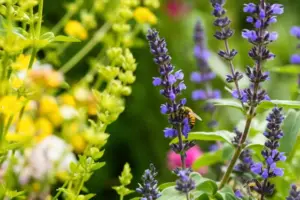
2. Building Bee Houses
Build bee houses together using simple materials such as wooden blocks, bamboo tubes, and cardboard tubes. This is a great way to provide nesting sites for native bees.
3. Observing Bees
Take children on bee-watching expeditions in the garden. Teach them how to identify different types of bees and observe their behavior. Make sure they understand the importance of not disturbing the bees.
4. Creating Bee-Themed Art
Encourage children to create bee-themed art using natural materials such as flowers, leaves, and twigs. They can make bee collages, drawings, or sculptures.
5. Reading Bee-Related Books
Read books about bees to children and discuss the importance of pollinators. This is a great way to educate them about bees in a fun and engaging way.
Documenting Your Bee Garden’s Progress
Keeping a record of your bee garden’s progress can be incredibly rewarding and helpful for future gardening endeavors. Here are some tips on how to document your bee garden:
1. Garden Journal
Start a garden journal to record your observations, planting dates, bloom times, and any challenges you encounter. Include photos and sketches to visually document your garden’s evolution.
2. Bloom Calendar
Create a bloom calendar to track when different wildflowers are blooming. This will help you plan your garden to ensure a continuous supply of food for bees throughout the growing season.
3. Bee Sightings Log
Keep a log of the different types of bees you observe in your garden. Note their behavior, the flowers they visit, and any other interesting observations.
4. Photo Documentation
Take photos of your bee garden at different stages of growth. This will allow you to visually track its progress and compare it to previous years.
5. Share Your Experiences
Share your bee gardening experiences with others through social media, blog posts, or local gardening clubs. This is a great way to inspire others and learn from their experiences.
Bee Gardening and Local Regulations
Before starting your bee garden, it’s essential to be aware of any local regulations or ordinances that may apply. Here are some things to consider:
1. HOA Regulations
If you live in a community with a homeowners association (HOA), check their regulations to see if there are any restrictions on the types of plants you can grow or the size of your garden.
2. Local Ordinances
Check your local city or county ordinances for any regulations related to gardening, landscaping, or beekeeping. Some areas may have restrictions on the types of plants you can grow or the use of certain pesticides.
3. Invasive Species
Be aware of any invasive plant species in your area and avoid planting them in your bee garden. Invasive plants can outcompete native species and disrupt the ecosystem.
4. Neighborly Considerations
Be mindful of your neighbors when planning your bee garden. Avoid planting tall or aggressive plants that could block their sunlight or spread into their yards. Communicate with your neighbors about your bee garden and address any concerns they may have.
Additional Tips for Success
- Start Small: Begin with a small area and gradually expand your bee garden as you gain experience.
- Observe and Adapt: Pay attention to which wildflowers are most attractive to bees in your area and adjust your planting accordingly.
- Be Patient: It takes time for a bee garden to become established. Don’t get discouraged if you don’t see results immediately.
- Connect with Local Experts: Join a local gardening club or native plant society to learn from experienced bee gardeners.
- Enjoy the Process: Bee gardening is a rewarding and enjoyable hobby. Take the time to appreciate the beauty of your garden and the vital role it plays in supporting bees and other pollinators.
FAQ
What is the best time of year to start a bee garden?
The best time to start a bee garden is in early spring or late fall, depending on your climate. Spring planting allows wildflowers to establish before the heat of summer, while fall planting gives them a head start for the following spring.
How do I choose the right wildflowers for my region?
Consult with your local agricultural extension office or native plant society for recommendations on the best wildflowers for your region. They can provide valuable insights into which species are most beneficial to local bee populations.
Do I need to use fertilizer in my bee garden?
Wildflowers generally don’t require heavy fertilization. However, if your soil is particularly poor, you can apply a light application of organic fertilizer in the spring. Avoid using synthetic fertilizers, as they can harm bees and other beneficial insects.
How often should I water my bee garden?
Water your wildflowers regularly, especially during dry periods. Water deeply but infrequently, allowing the soil to dry out slightly between waterings. Avoid overhead watering, as it can promote fungal diseases.
How do I control weeds in my bee garden?
Keep your bee garden free of weeds, which can compete with wildflowers for water, nutrients, and sunlight. Hand-pull weeds regularly or use a hoe to cultivate the soil. Apply a layer of organic mulch to help suppress weed growth. Avoid using herbicides, as they can harm bees and other beneficial insects.
What are some common pests and diseases that affect wildflowers?
Common pests and diseases that can affect wildflowers include aphids, caterpillars, fungal infections, and powdery mildew. Monitor your wildflowers for signs of these problems and treat them promptly using organic or natural methods.
How can I attract more bees to my garden?
In addition to planting bee-friendly wildflowers, you can attract more bees to your garden by providing a water source, avoiding pesticides, creating nesting sites, planting in clusters, and educating others about bee gardening.
Is it safe to have a bee garden if I have children or pets?
Yes, it is generally safe to have a bee garden if you have children or pets. Bees are typically docile and only sting when they feel threatened. Teach children to respect bees and avoid disturbing them. Keep pets away from bee nests and hives. Also consider learning more about dog safe indoor plants.
How long does it take for a bee garden to become established?
It takes time for a bee garden to become established. You may see some blooms in the first year, but it can take several years for the garden to reach its full potential. Be patient and continue to care for your garden, and you will be rewarded with a beautiful and thriving bee habitat.
Can I grow wildflowers in containers?
Yes, many wildflowers can be grown successfully in containers. Choose a well-draining potting mix and select wildflower varieties that are suitable for container gardening. Water regularly and provide adequate sunlight. Container gardening is a great option for those with limited space.
What can I do to support bees if I don’t have a garden?
Even if you don’t have a garden, you can still support bees by planting bee-friendly flowers in containers on your balcony or windowsill, avoiding pesticides, and supporting local organizations that promote bee conservation.
How to avoid plant diseases ?
To avoid plant diseases, ensure proper soil drainage, adequate sunlight, and good air circulation. Water plants at the base to avoid wetting the foliage, and remove any dead or diseased leaves promptly. Consider using organic fungicides or beneficial microbes to protect your plants. Also make sure you understand what does sulfur do for plants
How do i keep animals away from my garden ?
To keep animals away from your garden, use physical barriers like fences or netting. You can also try natural deterrents like sprinkling cayenne pepper around plants or using motion-activated sprinklers. Regularly inspect your garden for signs of animal damage and adjust your strategies accordingly. Consider that for some animals you might want to learn how to rabbit proof a gate.
Conclusion
Starting a bee garden with wildflowers is a rewarding and impactful way to support these essential pollinators and contribute to a healthier environment. By following the steps outlined in this guide, you can create a beautiful and thriving bee garden that provides food, habitat, and educational opportunities.
Remember to choose native wildflowers, provide a water source, avoid pesticides, and create nesting sites to attract more bees to your garden. Sustainable gardening practices, such as conserving water, reducing waste, and protecting soil health, are essential for creating a bee garden that benefits both bees and the environment. As you nurture your bee garden, don’t hesitate to explore other gardening practices like how to grow herbs indoors year round or even delving into more specialized areas like how to plant bare root peonies.
Embrace the journey, learn from your experiences, and share your knowledge with others to inspire a community of bee-friendly gardeners. Happy gardening, and may your bee garden flourish with buzzing activity and vibrant blooms!
Consider diversifying your gardening knowledge by exploring various plant care topics such as basil winter care or how to revive a dying strawberry plant.
Auto Amazon Links: No products found.
Perfect Plants Christmas Tree Saver 8oz. | Easy Use Xmas Tree Preserver Food | Have Healthy Green Christmas Trees All Holiday Season
$9.97 (as of December 3, 2025 00:36 GMT +00:00 - More info- Product prices and availability are accurate as of the date/time indicated and are subject to change. Any price and availability information displayed on [relevant Amazon Site(s), as applicable] at the time of purchase will apply to the purchase of this product.
Kaiedos Christmas Tree Watering Funnel - 39 Inch Funnel, Reusable Design, Makes Watering Your Live Tree a Snap!
$14.99 (as of December 3, 2025 00:36 GMT +00:00 - More info- Product prices and availability are accurate as of the date/time indicated and are subject to change. Any price and availability information displayed on [relevant Amazon Site(s), as applicable] at the time of purchase will apply to the purchase of this product.
Christmas Tree Watering Funnel, Real Christmas Tree Water Long Funnel About 40 Inch, Trees Watering System for Water Indoor Outdoor
$15.99 (as of December 3, 2025 00:36 GMT +00:00 - More info- Product prices and availability are accurate as of the date/time indicated and are subject to change. Any price and availability information displayed on [relevant Amazon Site(s), as applicable] at the time of purchase will apply to the purchase of this product.
IPOOLTENG Christmas Tree Watering Funnel 3 Tube 1 Funnels 40 Inch - 3 Section Plastic Christmas Tree Funnel Waterer, Long Funnels for Watering Trees, Best Gifts for Your Parents to Water Tree
$15.53 (as of December 3, 2025 00:36 GMT +00:00 - More info- Product prices and availability are accurate as of the date/time indicated and are subject to change. Any price and availability information displayed on [relevant Amazon Site(s), as applicable] at the time of purchase will apply to the purchase of this product.
1 Pack Christmas Tree Watering Funnel System, 44 Inch Christmas Tree Watering Stick with Adjustable 3-Section Design, Reusable & Spill-Free, Xmas Plant Waterer Tool for Indoor and Outdoor
$16.99 (as of December 3, 2025 00:36 GMT +00:00 - More info- Product prices and availability are accurate as of the date/time indicated and are subject to change. Any price and availability information displayed on [relevant Amazon Site(s), as applicable] at the time of purchase will apply to the purchase of this product.
Cuisinart 6.5" Cast Iron Smashed Burger Press, Round Flat Edge Grill Press for Crispy Smash Burgers, Burger Tool for Grill and Griddle Accessories, for BBQs and Tailgates
$24.99 (as of December 3, 2025 16:48 GMT +00:00 - More info- Product prices and availability are accurate as of the date/time indicated and are subject to change. Any price and availability information displayed on [relevant Amazon Site(s), as applicable] at the time of purchase will apply to the purchase of this product.
Muddy Mat® Shown on TV Super Absorbent Microfiber Dog Door Mat for Muddy Paws, Non-Slip Washable Pet Rug, Quick Dry Chenille Entryway Carpet, Machine Washable Indoor Outdoor mat, Grey 30"x19"
$19.95 (as of December 3, 2025 16:48 GMT +00:00 - More info- Product prices and availability are accurate as of the date/time indicated and are subject to change. Any price and availability information displayed on [relevant Amazon Site(s), as applicable] at the time of purchase will apply to the purchase of this product.
Snow Joe Premium Enviro Blend Ice Melt, Green-Coated Deicer Crystals, 50 lb - Safer Melter for Vegetation, Concrete & Metals w/ Anti-Corrosion Calcium Magnesium Acetate
$32.97 (as of December 3, 2025 16:48 GMT +00:00 - More info- Product prices and availability are accurate as of the date/time indicated and are subject to change. Any price and availability information displayed on [relevant Amazon Site(s), as applicable] at the time of purchase will apply to the purchase of this product.
OLANLY Dog Door Mat for Muddy Paws 30x20, Absorbs Moisture and Dirt, Absorbent Non-Slip Washable Doormat, Quick Dry Chenille Mud Mat for Dogs, Entry Indoor Entryway Carpet for Inside Floor, Grey
$9.99 (as of December 3, 2025 16:48 GMT +00:00 - More info- Product prices and availability are accurate as of the date/time indicated and are subject to change. Any price and availability information displayed on [relevant Amazon Site(s), as applicable] at the time of purchase will apply to the purchase of this product.
Zevo Flying Insect Trap Official Refill Cartridges - Fits Both Zevo Trap & MAX Indoor Fly Trap - Authentic Trap+Lock Technology to Catch Gnats, House & Fruit Flys (4 Official Refill Cartridges)
$14.97 (as of December 3, 2025 16:48 GMT +00:00 - More info- Product prices and availability are accurate as of the date/time indicated and are subject to change. Any price and availability information displayed on [relevant Amazon Site(s), as applicable] at the time of purchase will apply to the purchase of this product.
